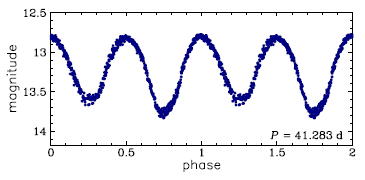 |
| Example of a RVa star variation in magnitude image Atlas of Variable Stars |
The reason for its variability is still a mystery: first cataloged as an eclipsing binary, it was theorized to be an RV Tauri variable in 2002, but if so, it would be by far the hottest such variable discovered.
EP Lyrae, a faint RV Tauri variable and an "extreme example" of a post-AGB star. It and a likely companion are surrounded by a circumstellar disk of material.
Wikipedia
RV Tauri variables
RV Tauri variables are luminous variable stars that have distinctive light variations with alternating deep and shallow minima.
These are not typical supergiants. These are post-AGB objects with low masses and they have lower luminosities than the bulk of the supergiants, so the spectral luminosity class is indicative of an evolved expanded star undergoing mass loss rather than an exceptionally luminous star.
They have ceased fusion and are rapidly losing their atmospheres on their way to becoming a white dwarf, Although this should happen in a period measured in thousands of years, even hundreds for the more massive examples, the known RV Tau stars have not shown the secular increase in temperature that would be expected.
The main sequence progenitor of this type of star has a mass near to that of the sun, although they have already lost about half of that during red giant and AGB phases. They are also thought to be mostly binaries surrounded by a dusty disc. Such stars are clearly metal-deficient Population II stars since it takes around 10 billion years for stars of that mass to evolve beyond the AGB.
RV Tauri stars are further subclassified into two types:
The prototype of these variables, RV Tauri is a RVb type variable which exhibits brightness variations between magnitudes +9.8 and +13.3 with a formal period of 78.7 days.
- RVa variables:these do not vary in mean brightness
- RVb variables: these show periodic variations in their mean brightness, so that their maxima and minima change on 600 to 1500 day timescales
The brightest member of the class, R Scuti, is an RVa type, with an apparent magnitude varying from 4.6 to 8.9 and a formal period of 146.5 days. AC Herculis is an example of an RVa type variable.
The luminosity of RV Tau variables is typically a few thousand times the sun, which places them at the upper end of the W Virginis instability strip.
Therefore RV Tau variables along with W Vir variables are sometimes considered a subclass of Type II Cepheids. They exhibit relationships between their periods, masses, and luminosity, although not with the precision of more conventional Cepheid variables. Although the spectra appear as supergiants, usually Ib, occasionally Ia although this may just need better measurements, the actual luminosities are only a few thousand times the sun which would make them bright giants.
RV Tau variables exhibit changes in luminosity which are tied to radial pulsations of their surfaces. Their changes in brightness are also correlated with changes in their spectral type. While at their brightest, the stars have spectral types F or G. At their dimmest, their spectral types change to K or M. The difference between maximum and minimum brightness can be as much as four magnitudes.
The period of brightness fluctuations from one deep minimum to the next is typically around 30 to 150 days, and exhibits alternating primary and secondary minima, which can change relative to each other.
The approximate division between W Vir variables and RV Tau variables is at a fundamental pulsation period of 20 days, RV Tau variables are typically described with periods of 40-150 days.
Wikipedia
Discovery
 |
| Friedrich Wilhelm Argelander (1799 – 1875) Image Wikimedia |
German astronomer Friedrich Wilhelm Argelander monitored the distinctive variations in brightness of R Scuti from 1840 to 1850. R Sagittae was noted to be variable in 1859, but it was not until the discovery of RV Tauri by Russian astronomer Lydia Ceraski in 1905 that the class of variable was recognised as distinct.
Wikipedia
Lydia Ceraski discovered 219 variable stars (or 180 – the literature disagrees somewhat). Among them are important ones such as SU UMa, RV Tauri and T UMi. Despite that, not much is known about her. She graduated from the Petersburg Teachers’ Institute and was married to the astronomer Witold Ceraski.
Gustav Holmberg
No comments:
Post a Comment